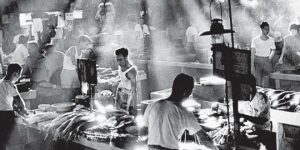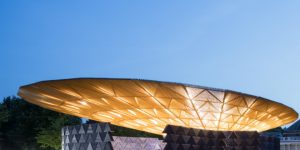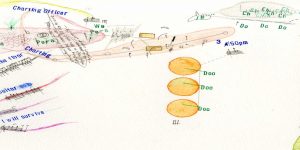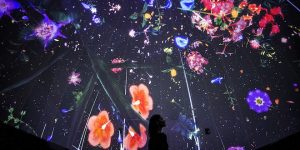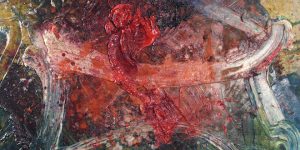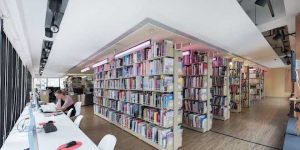Home Truly: Interview with Singaporean photographer Nguan
Nguan’s visual love story to Singapore as he sees it strikes a chord

Images from Nguan’s book ‘Singapore’, courtesy the artist
Nguan’s photographs of Singapore are meant to be savoured. Awashed in a rainbow of saccharine pastel colours, they present, in loving detail, ordinary moments in the lives of Singaporeans as they go about an uneventful day, such as taking a nap at the neighbourhood playground or reading the newspaper while waiting for the train to arrive.
In images where objects are the focal point, such as one with a broom and dustpan leaning against a pillar at the void deck of a Housing Development Board (HDB), or public housing, flat; or another with laundry billowing on a clothesline strung along the corridor, one can still imagine that a person has just left or is about to return, evoking a sense of warmth in these otherwise inconspicuous everyday sightings.

Images from Nguan’s book ‘Singapore’, courtesy the artist.
A keen observer of his surroundings and the human condition — loneliness is a recurring theme in his work — Nguan deftly captures a side of Singapore that is familiar to those who have grown up in the island city, and revealing for anyone who is curious about what Singapore is really like under the polished, prosperous veneer usually presented to the rest of the world.
ART REPUBLIK speaks with Nguan on the occasion of his book launch, ‘Singapore’, a collection of photographs taken over a decade from 2007 to 2017, his methods of working, and what he has up his sleeves in the coming year.
Why have you decided to put together this collection of images of Singapore? And how did you decide what to include in the book?
I’d been working on these pictures for a decade, and a book had been planned from the very start. I kept putting off its publication though, and in the intervening time the proliferation of the images on social media made me question if the book was necessary at all. In the end I decided that it was important to organise the pictures to give the work structure and clarify its purposes, because those can get lost when images are seen singly rather than as part of a coherent whole.
There is neither introduction nor captions in the book. Why the decision to omit texts?
I did write a short introduction, but I threw it out two weeks before going to press. I love working with photographs because of their subjectivity, I love how a photograph’s meaning can mutate over time, and I’m wary of how words can fix the reading of an image or a set of images. I also left out specific dates and other contextual information because they can be distracting.
You do have a quote from Stewart Brand about children drawing “standard” houses that are unlike HDB flats on your webpage about the book, and almost all of the photographs are situated in HDB residential estates. Do they represent Singapore to you? In addition, the cover image is taken from within a HDB block of another with a rainbow painted across it. Why did you choose it for the cover?
One of my goals when I started making pictures here in 2004 was to depict our heartland as a place of surreal beauty. It wasn’t easy at first to reimagine Singapore in this manner, and tiny shifts in perception had to occur before the door sprang open in my head. The photograph of the painted rainbow framed by corridor walls was instrumental in helping me to see our landscape in a new way, and ever since I took the picture I’ve had it in mind for the cover of the book. The artifice of a painted rainbow also says so much about Singapore and the calculated way in which we manufacture dreams, behaviour and territory.

Images from Nguan’s book ‘Singapore’, courtesy the artist.
There is a languor in the images, from a man sleeping on the slide at a playground to another crossing the road seemingly oblivious to the oncoming traffic. This is different from the busy urban-life, developed-city photographs that are typically associated with contemporary Singapore. Why are these scenes attractive to you?
I like that you’ve picked up on this, because I distinctly remember writing “languor of the day” early on in my notes. It was just something that struck me as unique about here: the unvarying length of our afternoons all through the year, the perpetual stickiness in the air and on our skin, the stillness. I wanted to convey all of this in my pictures. I have so many photographs in this series of people sprawled on the floor or across a bench, as if they were paralysed by the humidity.
The images remind me of my childhood spent in my neighbourhood after school in the 80s and 90s, but they are taken in recent times, yes? Do you think much has changed in the day-to-day life of ordinary folk in Singapore in the past decades? Do you consciously make the images appear to come from yesteryears?
My wish is for Singapore to appear somewhat mythical in the pictures, and it was a lot easier to achieve this by working in older parts of the city. Though I did look to my personal memories of Singapore for inspiration, the perceived nostalgia in my work is mostly a by-product of my location choices, the fact that I still shoot on film, and my contention that photography is an inherently nostalgic medium – it’s impossible to take a picture of the future, and the present becomes the past once you release the shutter.

Images from Nguan’s book ‘Singapore’, courtesy the artist
For the most part, do the subjects of your photographs know you are taking pictures of them? (Are they always candid? Are any posed?) And if so, what are their reactions?
All but one of the pictures in the book are candid. The reactions are in the photographs: they range from bemusement to startlement to indifference. Not everyone is aware of their picture being taken, even though I’m always up front about it. I use a relatively massive camera — they call it “The Texas Leica” because of its size — and I hold it up to my face every time I take a shot. Someone recognized herself in a print at my last show; she told me she liked the photograph but she wasn’t comfortable with it being in a show, so I took the print down.
Most of the subjects are shown as solitary figures, and not in pairs or groups. Your previous book, ‘How Loneliness Goes’ (2013), seems to put this front and centre. What continues to be compelling about it?
‘How Loneliness Goes’ was intended as a prelude to ‘Singapore’; it examined a single theme from the larger body of work. In ‘Singapore’, I persistently acknowledge a certain fraying of our social fabric. For example, kids are never shown with a parent in the book — they’re either with a grandparent, or left to fend for themselves in the jungle city. When I walk through a housing estate or around Geylang’s coffee shops in the mid-afternoon, I encounter so many men of a certain age sitting silently by themselves and staring into space, and of course I’m alone with my camera too, staring into a very similar space.

Images from Nguan’s book ‘Singapore’, courtesy the artist.
When you take a photograph, do you already have in mind how it’s going to look in its final version? What would you say is the most challenging/rewarding part of taking a photograph? Is it finding the shot (or waiting for the shot), sieving through the shots to choose one or editing the photograph?
My primary concern after taking a picture is, “Did I get the focus right?” That’s often all I can think about while I’m waiting for my negatives to be developed, because my camera is purely manual and I wilfully leave myself with very narrow margins for error. My second concern is usually, “Did he/she blink?” I feel like I have other elements under a fair amount of control, although the results of light interacting with film can still be wonderfully unpredictable. The most rewarding part of making a photograph is having something afterward that would have been nothing if it weren’t for you.
There are humorous juxtapositions in the book, such as a man prostrate on a void deck floor, followed by a cat in a similar position on a tiled bench. Was it a coincidence that you happened to have these two similar photographs to use in this way, or did you have this pairing in mind when taking one or both of the shots?
It was just something that I noticed and put together while going through my umpteenth edit of the book. Being able to choose from thousands of photographs makes editing hard as well as easy. I know that some photographers find it difficult to edit their own work, but I enjoy the process thoroughly, possibly because I went to film school, and montage is a basic skill for any filmmaker.
How did you decide on the general sequence of the images in the book? There seems to be several groupings: staircases, the act of cleaning up, the use of communication devices, cats, chairs, growing plants, construction/destruction.
There are eighty-two pictures inside the book, which is quite a lot if a cohesive body of work is the aim. So I settled on the idea of having informal “chapters” — loosely sorted according to theme, subject or colour — as an organising principle for the book. Not all of these chapters are meant to be easily distinguishable, and in fact it might be ideal if someone went through the entire book without becoming aware of its construction. But I am pleased with how each segment segues into the next, particularly in the second half of the book.

Images from Nguan’s book ‘Singapore’, courtesy the artist
Relating to the previous question, you seem to have put many of the images from the book (in a different order) on your webpage about the book. How do you work straddling between the digital space (website, Instagram) and in print? What are the freedoms and the restrictions in each for you, and also working in both at once?
They’re each extensions of the other. Social media and smartphones are altering the way in which art enters our being. It’s one thing to experience art in a museum or library when you’re girded for it, and quite another while you’re lying in bed, or when you’re in the middle of a brutal WhatsApp argument, or as you’re waiting for your crush to text back. We all know why we put on earphones to listen to music in a darkened room, and perhaps art comes inside us now in a similar way to how pop music does. It reaches us when our guards are down, in our most vulnerable moments. As a possible consequence the messages and reactions I get on platforms such as Instagram and Weibo are so fervent and emotional, and I suspect it’s the same or amplified for other artists who are prolific in the digital sphere.
Who/What is Maybe Hotel aside from being the publisher of this book?
It is the name of my new publishing imprint and future art space. It’s a rest stop for possibilities; a shelter for the perhaps. I’ll do more with it in the years to come — I’m keeping it low key at the minute. I realise that while I’m fairly spry I should be out on the street, making new pictures.
You had an exhibition at FOST Gallery earlier this year. What was that experience like and will you be mounting another solo exhibition or taking part in a group one anytime soon? What’s in the pipeline for you for 2018?
If social media is the radio and books are albums, I’d liken exhibitions to concerts – they should be immersive, transcendent experiences, and you should always feel as if the artist is in the room with you. We had so many people come out to my show at FOST, which was really gratifying. I’d love to mount an exhibition in 2018 for the Singapore work, but I’m going to need a suitably large venue.




